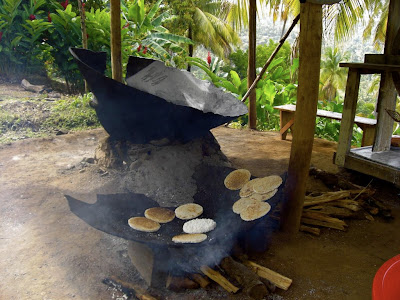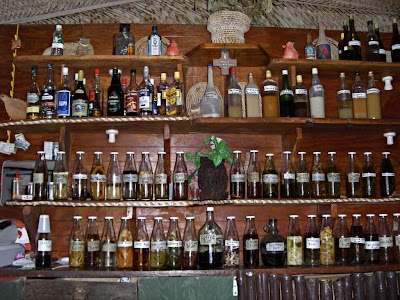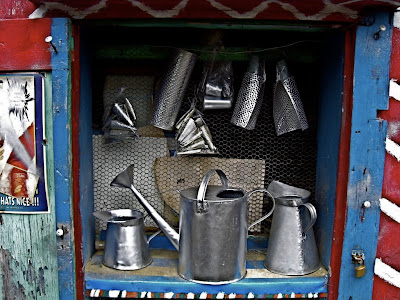The food writer Catherine Phipps is the author of next Saturday’s meal at The Underground Restaurant. I asked her to write a guest blog post on her time spent as a cook working in Dominica. Here is her beautifully evocative piece:
The first time I heard about Dominica was when I was mooching around the weekly food market in Nevis – most of the stallholders were farmers from Dominica who made a precarious and dangerous living, travelling up and down the Caribbean archipelago in open boats for regular market days. A few years later, I had carved a niche for myself there. From the moment I first saw the island from the air, I was enthralled. The interior looked forboding and gave me goosebumps – dense impenetrable-looking rainforest covered volcanic mountains. Everything was covered in wisps of mist – I couldn’t tell whether it was cloud, smoke or steam – it was probably all three. I understood why it was said that it was the only island Columbus would still recognise today – it looked uninhabitable.
Read Jean Rhys’ Wide Sargasso Sea and you’ll get a feel of Dominica. It’s true that it’s one of the greenest, most unspoilt of all the inhabited Caribbean islands (on overcast, humid days, the relentless green can sometimes feel oppressive, although I associate the island with colour and feel deprived of it back in the UK), but much of it is cultivated and it does act like a breadbasket for drier, more arid parts of the Caribbean. We import its Fairtrade bananas (along with those from St Vincent and St Lucia). The fact that it hasn’t been stripped of its resources is down to luck and failure – sugar plantations never took off there, cocoa and coffee has never been produced on a large scale. Everything is produced in small amounts so the ecosystem has been preserved (it rains somewhere on the island every single day, water is never in short supply). Virgin rainforest sits comfortably with cultivated land (although there are now problems with fertiliser use), secondary rainforest has reclaimed abandoned plantations. The land is incredibly fertile and cut through with numerous streams and rivers allegedly one for every day of the year, just like Antigua and its beaches, with some spectacular waterfalls.
I loved my winters in Dominica. I was working long, hard hours in a small hotel kitchen, but there were some very civilised benefits – I often managed to have a morning swim after breakfast service, I would keep the hotel owner’s octogenarian mother company during afternoon tea when we would play canasta and she would dispense advice on my (then) hopeless personal life as well as regale all with stories of her time as an entertainer in Italy during WW2. In the evenings glamming up a little was mandatory, not least because I had to wear heels just to reach the top shelves in the bar. I would flit between overseeing dinner service and mixing cocktails, listen to the over-confiding guests (always noticeably more emotional during the full moons) and occasionally dance, when my boss, an excellent musician, deigned to play a few old standards on the baby grand. It felt more like an endless country house weekend than a busy, full to capacity, hotel.
The kitchen was lovely to work in – cool and breezy thanks two large doors at either end which had been designed so the tradewinds could blow straight through. Many mundane jobs were done outside on the terrace, sea views to the front, dominated by one, leggy palm tree and terraces of fruit trees and distant rainforest covered mountains behind. Cracking open and destringing tamarind, deboning smoked herring or salt fish (both popular for their cheapness), deseeding sorrel (a flower similar to hibiscus) for jam or juice, or grating coconuts became a pleasure, especially when I had kitchen and hotel staff to talk to.
All of them made it their business to teach me the patois (now for the most part forgotten) and I made it my business to learn as much as possible about their food – the growing, cooking and eating of it. Jean, a gentle faced man from Haiti stripped the coffee tree next to his house of its fruit and taught me how to process the beans right up to dry roasting them in a frying pan – he also taught me how to recognise the now unmistakable smell of the large boa constrictors occasionally found in the hills above the hotel. I also learnt how to process cocoa, watching locals dry the beans in the sun behind their houses – and that I never needed water when out walking along the country lanes close to the hotel, as I could always pick a ripe cocoa pod, eat the white flesh which cocooned the beans for instant refreshment and energy boost. Anise took me up to her father’s land in Carib Territory (the only reservation in the Caribbean, really called Kalinago – they hate the Carib moniker and its cannibalistic connotations) to show me how watercress had colonised great swathes of the fast running stream which cut through his carefully farmed terraces. Mona taught me a couple of the dishes on this menu, and a visit to her sister’s hog farm resulted in a lively discussion with all the staff about exactly how boudin noir should be spiced. James made me baskets from woven larouma and bowls from the calabash which hang in my kitchen today. I cooked vegan food over fire with a strict Rastafarian, tried a zillion types of infused cask rum (regretting the marijuana rum, one sip of which floored me), learnt to recognise my seasoning peppers from my hot, haggled with the boys who would turn up at the kitchen with buckets filled with fresh water crayfish or titiri (teeny little fish used to make accras) and made the most of the abundance of fresh produce.
The traditional diet in Dominica is very healthy – lots of anti-oxidant rich fruit – mangoes as big as a small child’s head, sour carambola (starfruit) totally different from the insipid sweet variety we get here, custard apples, sour oranges (essential for rum punch), nutty red bananas, despised by the locals as they aren’t as sweet as their yellow cousins, fresh coconuts. There is little meat or dairy, seafood is sold at a premium which is why most people eat more salt fish and smoked herring than fresh, and every meal is predominantly provisions – the starchy foods which make up the bulk of every meal – green bananas, tania, dasheen, cassava (also ground up and made into a rough textured, nutty flatbread), breadfruit (best cooked whole over charcoal. Scrape off the blackened skin, cut into slices and fry in butter or coconut oil) and of course the myriad variations of rice and peas or beans. The carbs were necessary because the work throughout most of Dominica was intensely physical, and most people walked everywhere or hitch lifts. People in Carib Territory regularly used to live in their 100s, but things have changed now of course. People aspire to more sedentary jobs, they are more dependent on processed foods, sold in the supermarkets which will not let you buy unless you pack your purchases in their disposable plastic bags, cars snake round the block queuing for the drive thru KFC and obesity has become increasingly common amongst the younger generation. The main market in Roseau (which starts at 2am on Friday morning) still sell oil drum-grilled plantain, rotis and doubles but US style fast food is gaining ground.
The cuisine and (unofficial) language is French-Anglo hybrid, testament to the fact that Dominica changed hands frequently between the two. Creole dishes are popular, as are many dishes found in Martinique and Guadaloupe , accras (chewy, savoury beignets flavoured with conch, salt fish, titiri) – crab farci, fish bouillon, curry Colombo are common, as well as the stew downs – all spicy hot, all started with a little brown sugar and butter (everyone in the Caribbean has a sweet tooth). Some of the flavours are surprisingly Mediterranean – lots of parsley, intense bush basil, garlic and of course the “cieve n thyme” combination which is always sold together – cieves are very long spring onions, always accompanised by bundles of woody thyme. The biggest surprise for me was that there is little coriander leaf used in the Caribbean – just chadon beni which has a similar, if stronger, flavour. Finally, my absolute favourite ingredient which I used in everything is sadly unavailable here – the “seasoning pepper” has the same fruity, aromatic qualities of the scotch bonnet pepper, but with a very mild heat, which means you can use it for flavouring in dishes where the other ingredients will be overwhelmed by scotch bonnet’s intensity. My last lot of seeds failed and I’ve yet to find them in the UK. I live in hope!
We’ve based our menu on these flavours, to give guests a taste of Dominica and the French West Indies, rather than the Jamaican food most Brits are more familiar with.
Tickets are available here.
All photographs copyright of Catherine Phipps.











Very interesting! I share your views on the Seasoning Peppers vs Scotch Bonnet argument. SB is FAR too hot to be useful, in my opinion.
Try the scotch bonnets Sainsbury's sell – they're fairly mild so could perhaps stand in for the seasoning peppers!
I wish, Sarah.
Mark – have you ever found Seasoning Peppers here? I've been looking since my seeds failed – 3 years ago. I've asked in just about every West Indian shop I've come across in London, to no avail.
I've tried and failed to find seasoning peppers too but having never tasted one I expect my longing isn't as great. It's still pretty powerful though! I've had quite a few comments on Caribbean dishes on my blog which have urged me to try and find them. No luck though. Where did you buy the seeds?
I didn't buy them – they were saved from the last time I was in Dominica – I bought loads of peppers and their seeds back – but that was back in 2009. I had some left which got mislaid during my last move (over 2 years ago). Was gutted.
I am following up leads on seasoning peppers at the moment, and live in hope 😉